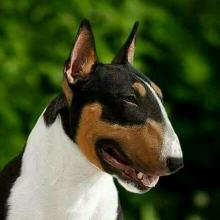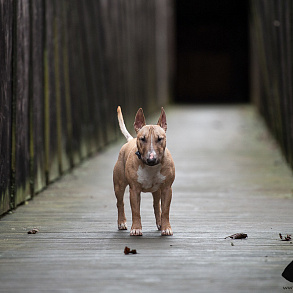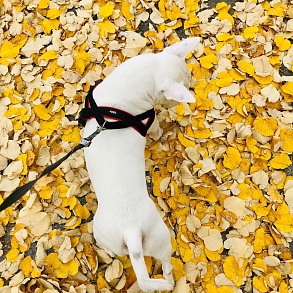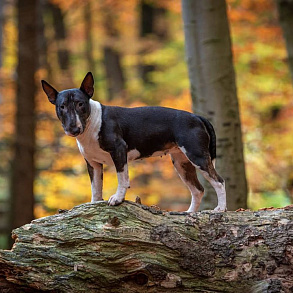Mini Bull Terrier

Mini Bull Terrier is a British breed of dog that originates from standard bull terriers and differs from them in a more compact physique.
Brief information
- Breed name: Mini Bull Terrier
- Country of Origin: UK
- Birth time of the breed: 1991
- Weight: no more than 8 kg
- Height (height at the withers): 25-35 cm
- Life expectancy: 12-14 years old
Highlights
- The Mini Bull Terrier is a very sociable breed that does not know how to cope with loneliness, so it is not recommended for keeping busy people and single owners.
- The friendliness that a dog shows to a person does not apply to pets that mini bull terriers harshly treat.
- It is desirable that a person with experience should be engaged in dog training. The breed is distinguished by independence and stubbornness when it comes to boring, in the opinion of its representatives, things.
- Dogs do not tolerate the Russian climate too well, so in winter and autumn the mini-bull will need insulated clothes for walking.
- The breed is ideal for people who do not want to waste time caring for their pet's fur. The dogskin of the minibules sheds sparsely and needs only occasional combing.
- Miniature bull terriers are undemanding to the dimensions of housing and easily adapt to living in ordinary apartments, provided that they are well and productively walked.
- Mini-bulls make excellent companions and very mediocre watchmen, so it is better to choose another breed for serious protection of housing and property.
Mini Bull Terrier - a clockwork gambler and egoza, whose self-will cannot be suppressed. Good-natured to humans and tough on any small animals, this egghead energizer has remarkable intelligence. That's just to use his high mental abilities, the mini-bull prefers exclusively for personal purposes. In school, the dog is more likely to pretend to be a charming "incomprehensible" or turn on the obstinate leader mode than agree to follow strict rules. Yes, the mini-bull is trained and controlled, but he is not a fan of the impeccable execution of commands and will always prefer sports exercises to classes, and better yet, a game.
Breed characteristics
History of the mini Bull Terrier breed
Miniature and standard bull terriers have common ancestors and remain the closest relatives themselves. Basically, the breed was bred by selection, because in litters standard bull terriers puppies were always born that differed from their counterparts in more modest dimensions. At first, the underage animals were regarded as a plembrak, until the British breeders came up with the idea to form an independent breed from them.
In 1914, tiny dogs, which were dubbed toy bull terriers, were first shown at the London exhibition. However, further breeding work came to a dead end: enthusiasts who began to breed animals were confused by the fact that dwarf individuals gave defective offspring, and even with a bouquet of genetic ailments. After working on the mistakes, the breeders decided not to get carried away with the extreme characteristics and brought out slightly larger dogs that were inferior in size standard bull terriers , but superior in size to the dogs. Representatives of this variety were called miniature bull terriers.
In 1938, the Mini Bull Terrier Club began its work in the UK, and just a year later the breed was recognized by the English Kennel Club. It is also worth noting the fact that the dogs bred in this time period were standardized not by weight, as was done earlier, but by height. In America, the first "fan club" of the breed opened in 1966, while registering miniature relatives in the AKC standard bull terriers started only in 1991.
Animals entered Russia in the 90s, when fighting dogs became popular among criminal authorities. Not that bull terriers were particularly bloodthirsty, but due to their specific appearance, they immediately became in demand. As for the mini-bull terriers themselves, they, first of all, charmed the owners of Russian standard apartments. There was not much space in such housing, so the mini-bull became an excellent "compromise" for dog lovers who want to have a formidable-looking, but undemanding pet.
Video: Mini Bull Terrier
Breed standard mini Bull Terrier
Externally, a miniature bull terrier is a reduced copy of the representatives standard breed lines. Muscular, with pronounced backbone power and egg-shaped heads, mini-bulls represent the type of supercharismatic pets to which the attention of others will always be riveted. The lower limit of growth for a mini bull terrier is 35.5 cm. In this case, the dog may be slightly higher than the set bar, but in no case lower. Weight restrictions in the case of this breed do not apply, but it is imperative that the dog looks harmonious. Overweight, as well as overly lean individuals will not make an exhibition career.
Head
The deep, evenly filled head of the miniature bull terrier is distinguished by an elongated profile and an ovoid shape. The top of the skull is flattened, the surface of the muzzle is without hollows and excessively raised areas.
Nose
The back of the nose is bent down at the tip. The nostrils are normally open, the lobe is evenly colored in a black tone.
Teeth and bite features
The lower jaw looks especially deep and prominent. Strong teeth stand in rows evenly, and the teeth of the upper jaw go to the lower ones, forming a complete scissor-shaped bow (bite).
Ears
The mini bull terrier has thin and neat ears located close to each other. The ear cloth is in an upright position, the tips of the ears are directed straight up.
Eyes
The eyes of mini bull terriers are characterized by a triangular shape, due to which they look very narrow and small. The iris is colored dark brown, often close to coal-black. Important ratio: the distance from the eyes to the occipital protuberance should be less than from the nose to the eyes.
Neck
The beautifully curved and long neck of the miniature bull terrier is covered with dense muscles. There are no folds. The base is noticeably thicker than the upper part of the neck, but the transition between them is smooth.
Housing
All representatives of the breed have compact bodies with strongly curved ribs. The gap of the body between the withers and the chest is very deep. The back is short, convex in the lumbar region and smooth in the area behind the withers. The lower abdomen forms a smooth curved line, maximally selected in the groin area.
Limbs
A thoroughbred mini bull terrier confidently stands on strong, muscular legs, for which a parallel delivery is typical. The length of the limbs and the depth of the chest have the same value (only for adults). Not overloaded oblique shoulder blades are closely adjacent to the sides, forming right angles with the shoulders of the dog. The forearms are formed by strong rounded bones, the pasterns are fixed in an upright position.
The hind legs of the mini bull terrier are impressive hips, well-defined knee joints and strong shins. Hocks with normal angles, metatarsals shortened, but strong. The paws of the animal are small, rounded, fingers with a clear bend. The miniature bull terrier moves flexibly, without stiffness. When trotting, all four legs move synchronously, when accelerating, the paws are placed closer to the center.
Tail
The mini bull Terrier's short tail is set low. The tip of the tail is thin, the base is thick.
Wool
Short, moderately hard hair has a nice shine. The undercoat of the breed appears seasonally, more precisely, closer to winter.
Color
Mini bull terriers can be either completely white or colored. Individuals of solid white color may have spots on the head and pigmented skin. Colored bull terriers come in black-tiger, fawn, red and tricolor suits. Prohibited color options: speckled on a white background, brown-liver, blue.
Disadvantages and vices of the exterior
The list of defects in the appearance of the breed is the same as that of standard bull terriers . Individuals with light eyes, mottled lobe, loose-hanging and folded skin, twisted joints, long hair and non-standard colors cannot claim high exhibition marks. Serious defects of the exterior also include cryptorchidism, depigmented skin of the nose, deafness and spots on the body of white dogs.
The character of a miniature bull terrier
In mini-bull terriers, there is practically nothing left of the bloodthirsty ancestors who were bred for dog fights and rat baiting. Today's representatives of the breed are positive vivacious, adoring outdoor games, running around and various pranks. Of course, they are not always good guys and are not averse to being stubborn in order to test the endurance of the owner for steadfastness, but aggression is not peculiar to the breed.
Mini bull terriers are completely unsuitable for the role of apartment guards. The maximum that a dog can give out when a stranger approaches is a warning bark. However, this action occurs only when the pet is rudely provoked. The friendly-minded outsiders are hospitably greeted by the mini-bull on the threshold, trying to lick the hand sycophantly. But in relation to representatives of the fauna, the genes of brutal ancestors are still making themselves felt. For this reason, most dog management manuals strongly do not recommend letting the mini bull terrier off the leash on walks - the four–legged bespredelschik will rush off after the first cat, pretending that he does not hear your shouts at all.
It is not necessary to keep domesticated rodents and a dog in the same territory. In a permanent confrontation, one person will survive, and this someone will definitely not be a hamster. To whom mini bull terriers are able to make concessions, it's children. Firstly, because in their hearts they think they are more stupid than themselves, and secondly, because it is the kids who can satisfy the dog's need for games. The most terrible test for the breed is loneliness. In principle, mini-bulls are not adapted to while away the hours waiting for the owner, so for any loner with an irregular work schedule, the dog will quickly turn into a problem.
Education and training
Dog handlers refer miniature bull terriers to the number of highly intelligent, but difficult-to-train breeds. As a result: it is better to lower the bar of requirements for "egghead meteors" immediately. Take into account the fact that all representatives of this family are pronounced dominants who do not tolerate being rigidly put in place. In this regard, it will be necessary to maintain a balance of relationships, namely: to show the dog that the leader in the house is still the owner, but at the same time avoid authoritarianism in communication.
It is easy to encourage a mini-bull to feats with praise and delicious bonuses, so for each successfully completed task, the pet needs to be positively stimulated. Too much reliance on the high intelligence of the breed is also not worth it, so in the process of learning commands, do not be lazy to help the dog. For example, when giving the order "Sit down!", lightly press your hand on the animal's back, forcing it to get down on its paws.
It's better to present new techniques in an entertaining way: mini bull terriers are still gamblers. But to expect perfect execution of commands from representatives of the breed is a meaningless activity. Miniature bull terriers did not get the perfectionism of service dogs, so accept that your requirements will not be fulfilled immediately and not exactly as you would like. It is advisable to demand perfect adherence to the rules only in everyday situations, when the comfortable life of others depends on the behavior of the pet.
As for special training programs, it will not be possible to "jump" above the course of the UGC with a miniature bull terrier. But with this friend you can practice sports disciplines. The best thing for the breed is jogging behind the owner's bike, agility, pitch and go. And here is veitpulling, which often involves standard bull terriers , in the case of their miniature relatives, it will not work.
Ideally, the head of the family should be engaged in dog training. It is better not to try to involve children in this business: the mini-bull, of course, is not averse to fooling around with them, but this does not prevent him from considering the children a head below himself. No physical punishments should be applied to even a dog that has fairly shaken its nerves. If the dog is too loose, it is easy to restrain him with a stern look, taking away his favorite toy or depriving him of a delicacy that the pet was counting on. Just act in hot pursuit: punishing the mini-bull for the wallpaper torn last week is useless. The dog remembers the crimes just committed and managed to forget about yesterday's ones, so he will take your claims for unjustified infringement of her rights.
Maintenance and care
Miniature bull Terrier is an ideal apartment dweller, able to exist happily even in conditions of limited space. It is important to understand that the breed is not decorative. In order for the miniature bull terrier not to tear the house to shreds, you need to walk with it for a long and productive time. It is ideal to combine walking with useful activities, such as sports exercises. During the season, you can take a mini–bull with you on a picnic or on a hunt - dogs like to chase game.
If sport and trophy chasing are not suitable for some reason, you will have to think about how to unload the animal on a walk. The most popular options are harnesses with weights, jogging on loose sand and uphill. Do not forget about toys: with them, a miniature bull terrier takes away the soul of the house, which helps him to refrain from destructive games.
Important: sports, running with weights and other energy-consuming entertainment can be practiced no earlier than the puppy turns 8 months old.
Hygiene
If you want to save money on groomer services and hair care products, the mini–bull is your dog. The smooth short dogskin of the breed has a dust-repellent property, and the scanty undercoat that grows by winter never forms tangles. Running after an animal with a comb is also not necessary: to maintain a neat appearance, it is enough to collect dead hairs from the dog's body once or twice a week with a rubber glove or brush. However, there are disadvantages to smooth wool. For example, such a dogskin very poorly protects the body of a mini-bull from low temperatures, so for walking on frosty days you will have to get a insulated jumpsuit.
Short hair does not save you from insect bites, which can provoke allergies. To prevent this from happening, use repellents and protective blankets during trips with the dog to nature. Mini bull terriers are supposed to have their claws trimmed once a month. Be sure to monitor the health of the pet's eyes – remove the lumps of mucus formed in the corners of the eyelids with a clean cloth, which can be additionally moistened with a decoction of chamomile. For weekly ear cleaning, use hygienic drops or lotions.
Feeding
The basis of the natural diet of mini bull terriers are lean meats (beef, rabbit, chicken), raw tripe, liver, fermented dairy products of reduced fat content and sea fish, cut into fillets. For safety reasons, the meat must be pre–frozen or doused with boiling water - this will help kill the eggs of worms and microorganisms that cause digestive problems. You can give buckwheat and oatmeal porridge, but you should not get too carried away with adding cereals to the diet.
Miniature bull terriers are useful for any vegetables, except legumes and potatoes, as well as fresh greens. It is better to give these products raw and finely chopped. 3-4 times a month, a pet can be treated with a boiled chicken egg. As a source of fiber, it is recommended to use special bran for dogs. Before giving them to the animal, the bran should be soaked in kefir or broth and let them swell. Vitamin and mineral fertilizing with natural feeding is mandatory. Only mini bull terriers that feed on industrial dry food do not need dietary supplements.
Health and diseases of mini bull Terriers
The breed is haunted by only three genetic diseases, and all of them are inherited in an autosomal recessive way, that is, when both parents are carriers of a defective gene. The most common ailment among miniature boules is primary dislocation of the lens. The disease is treated surgically, but it is dangerous because in advanced stages it leads to complete blindness.
A very rare hereditary pathology is LAD, aka lethal acrodermatitis, manifested at the age of 6 months to 2 years. The puppy, a sick LAD, lags behind in growth, suffers from diarrhea and focal skin lesions on the muzzle and paws. Sometimes carriers of the disease have hyperkeratosis and lightening of the coat (with the exception of white individuals). Another hereditary disease of mini-bull terriers is laryngeal paralysis. What is characteristic: pathology can manifest itself both by itself and due to mechanical damage to the throat (injuries, insect bites, tumors).
How to choose a puppy
- Trust only breeders who have provided the results of testing both manufacturers for genetic diseases.
- Feel the puppy's tail carefully: there should be no knots and creases on it.
- Be sure to ask the breeder to provide a litter inspection report carried out by a specialist of a breed club or a cynological organization.
- Dog handlers do not recommend taking too phlegmatic mini-bulls. As they grow older, they become even slower and less amenable to training. Always give preference to active and inquisitive kids.
- Don't take the fattest puppy in the litter. Corpulent forms are not an indicator of good health.
- If there is little experience in training dogs, choose a female puppy. The bitches of the mini bull terrier are always softer, more contact and learn faster.
- Specify how many babies the bitch feeds in total. The best option is 5-7 puppies. If the litter is larger, most likely there is not enough mother's milk for mini bull terriers, which means that the offspring will not have the strongest immunity.
- Extreme caution should be taken with too small litters. Basically, a couple of puppies are brought by young bitches of mini bull terriers giving birth for the first time. A small number of babies in a mature dog may be the result of an intrauterine infection, as a result of which some puppies die, therefore it is undesirable to take an animal from such a parent.
Price of a mini bull terrier
There are very few registered nurseries in Russia engaged in breeding the breed. Perhaps that is why miniature bull terrier puppies are much more expensive than their standard tribesmen. The average cost of a dog in the Russian zoo market – $700 – $800. Exhibition mini-buses will cost an even more significant amount – from $1200.


